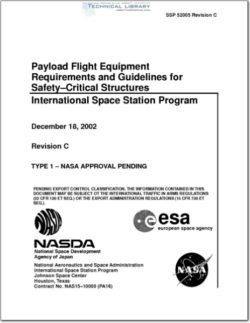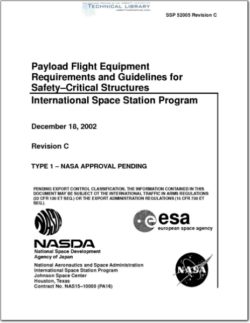NASA-SSP52005RC

- Version
- 378 Downloads
- 1.12 MB File Size
- 1 File Count
- May 18, 2016 Create Date
- May 18, 2016 Last Updated
Payload Flight Equipment Requirements and Guidelines for Safety - Critical Structures

This section provides an overview of the safetyicritical structures process, including definitions
and classifications, and forms the basis for further discussion. It is intended to introduce, not
cover, the detailed requirements provided in later sections.
The structural integrity of payload flight equipment is a critical flight safety concern. Flight
safety of the payload equipment shall be assured by structural analysis and/or tests. These
analyses and/or tests are for the purpose of assuring that structural failure does not create a safety
hazard. They are not, however, intended to cover the functional integrity of the experiment
unless loss of functionality could create a hazard to the STS/ISS or crew.
All structural elements including associated interfaces, fasteners, and welds in the payload
component primary load path, including pressure systems, uncontained glass, rotating
machinery, mechanical stops, and containment devices, are safety critical and shall be analyzed.
For cargo bay exposed payloads (i.e. payloads mounted to a side wall carrier or to an across the
bay carrier), the definition of safety critical structure is expanded to also include all secondary
structure that has significant dynamic response of its own or is important to the overall response
of the carrier. Safety critical structural elements shall be shown to have positive margins of
safety or, in the case of containment devices, be proven to be structurally adequate against
penetration. The primary load path is defined as the collection of structural elements which
transfer load from one part of a structure to another. Elements in the primary load path
experience loading in excess of that created by their own mass. Examples of non—SCS hardware
would include electronic components (which can be shown to be contained inside a box) whose
failure would not create a hazard, printed circuit boards, switch covers, and their associated
fasteners.
Stowed hardware which is packed in foam is generally considered to be non—safety critical.
Items which are soft stowed in foam and bags do not need to consider random vibration loads in
addition to the low frequency load factors of SSP 57000, table 3.1.1.3—4. This does not mean
that there is no random vibration environment. It is assumed that the loads imposed by the
random vibration environment as seen by the item encased by foam will be small enough
(effectively zero) to be neglected in design consideration. Normally the payload developer will
conduct a workmanship vibration test (strongly suggested for payloads containing moving parts,
mechanisms, or electronics) to ensure that manufacturing defects are discovered and corrected.
The vibration level and duration of workmanship vibration tests are determined by the payload
developer or the sponsoring agency.
| File | Action |
|---|---|
| NASA-SSP52005RC Payload Flight Equipment Requirements and Guidelines for Safety - Critical Structures.pdf | Download |
Comment On This Post